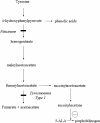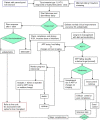Recommendations for the management of tyrosinaemia type 1
- PMID: 23311542
- PMCID: PMC3558375
- DOI: 10.1186/1750-1172-8-8
Recommendations for the management of tyrosinaemia type 1
Abstract
The management of tyrosinaemia type 1 (HT1, fumarylacetoacetase deficiency) has been revolutionised by the introduction of nitisinone but dietary treatment remains essential and the management is not easy. In this review detailed recommendations for the management are made based on expert opinion, published case reports and investigational studies as the evidence base is limited and there are no prospective controlled studies.The added value of this paper is that it summarises in detail current clinical knowledge about HT1 and makes recommendations for the management.
Figures


References
-
- Chakrapani A, Gissen P, McKiernan P. In: Inborn Metabolic Diseases. 5. Saudubray J-M, Berghe G, Walter JH, editor. Heidelberg: Springer; 2012. Disorders of Tyrosine Metabolism; pp. 275–276. Chapter 18.
-
- Couce ML, Aldámiz-Echevarría L, Baldellou A, Blasco J, Bueno MA, Dalmau J, De La Vega A, Del Toro M, Díaz C, Lama R, Leao E, Marrero M, Navas VM, Pintos G. Recommendations and management of type I hereditary or hepatorenal tyrosinemia. An Pediatr (Barc) 2010;73:279. e1-4. - PubMed
Publication types
MeSH terms
Substances
LinkOut - more resources
Full Text Sources
Other Literature Sources
Medical
Molecular Biology Databases

